Library
 CIBD Membership Required
CIBD Membership Required
Environment and safety considerations for beer dealcoholisation
By: Sarah Laing
24/02/2021
Non-alcoholic beers have taken off in Europe and are gaining interest elsewhere in the world. Dealcoholisation of beer via vacuum stripping is commonly utilised technology for production of non-alcoholic beer. This paper covers the safety and environmental factors used in the design, construction and operation of the Yatala project.
 CIBD Membership Required
CIBD Membership Required
Where has all the research gone?
By: Charlie Bamforth, Garry Menz, Doug Stewart
24/02/2021
The dissolved oxygen level in bright beer is a key quality parameter that is critical to the freshness and shelf life of the beer. Breweries strive to avoid contact of beer with oxygen post fermentation in order to reduce off flavour due to oxidation, allowing the beer to stay fresher for longer. The aim of reducing the dissolved oxygen content in bright beer was undertaken by Cascade Brewery (Tasmania, Australia).
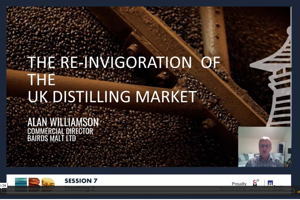 CIBD Membership Required
CIBD Membership Required
The re-invigoration of UK distilling malt market
By: Alan Williamson
23/02/2021
Over the last 30 years the Distilling market in UK (Scotland) has grown from requiring 300,000 tonnes per annum to the primary UK malt market consuming ~900,000 tonnes today. This focus on distilling malt production has resulted UK plant breeders developing malting barley lines that are low protein accumulators, non GN producers that are capable of producing highly modified malt that is capable of supplying high extract/high spirit yield potential.
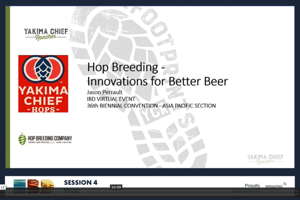 CIBD Membership Required
CIBD Membership Required
Hop breeding innovations for better beer
By: Jason Perrault
23/02/2021
Over the past decade hop usage in brewing has changed dramatically. Research on the compounds driving hop flavor and aroma has increased as a result thus dramatically improving our knowledge of the subject. Discover the process of breeding new hop varieties with five experimental hop varieties all creating marked differentiation in hops and brewing.
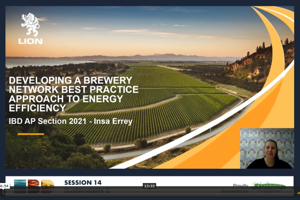 CIBD Membership Required
CIBD Membership Required
Developing a brewery network best practice approach to energy efficiency
By: Insa Errey
24/02/2021
Need from Speaker
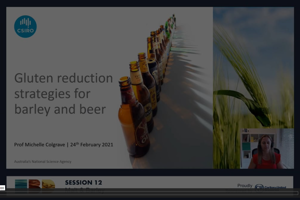 CIBD Membership Required
CIBD Membership Required
Gluten reduction strategies for barley and beer
24/02/2021
In this presentation, by employing advanced proteomics analysis, a novel ultra-low gluten (ULG) barley variety in which the hordein (gluten) content was reduced to below 5 ppm using traditional breeding strategies will be described.
 CIBD Membership Required
CIBD Membership Required
Biotransformers...Hop flavours in disguise!
24/03/2021
Lallemand Brewing provide the right tools to brewers to brew great beers and achieve always a higher quality of the finished beer. The choice of yeast strain is an important consideration in brewing any IPA style. Recent research is uncovering how different yeast strains can influence flavour and aroma by interacting with specific hop-derived flavour compounds, a process called biotransformation.
 CIBD Membership Required
CIBD Membership Required
Unique and sustainable on-farm craft malting for industry
By: Stuart Whytcross
24/02/2021
A keen interest in beer and spirits saw Stu and his friend, Brad Woolner, establish Australia’s first on-farm craft malthouse. Discover the Voyager Craft Malt story and their unique and sustainable on-farm malting process. Delving deeper into what craft malting is by highlighting successful partnerships and collaborations between brewers, farmers, maltsters and consumers who grow and create a range of innovative malted products for specialty beers and spirits.
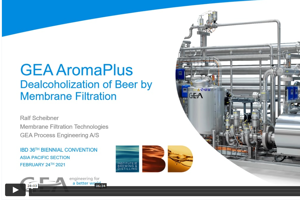 CIBD Membership Required
CIBD Membership Required
The Dealcoholisation of Beer with the new GEA AromaPlus Technology
By: Ralf Scheibner
24/02/2021
The consumption of alcohol-free and low alcohol beer is believed to see continuous growth due to consumers seeking for alternatives to alcoholic or unhealthy sugary beverages. This can be produced through biological or technical methods. GEA will give an overview on the latest development for the new GEA AromaPlus membrane technology to dealcoholize beers to ≤ 0,5% abv or down to ≤ 0,05% abv with no thermal stress and high retention of flavor compounds.
 CIBD Membership Required
CIBD Membership Required
Flavor stability: a realistic target?
By: Charlie Bamforth
24/02/2021
The flavour of beer changes with time, is this thought to be a bad or good thing? This talk will look into if the shelf life of beer can be genuinely enhanced? Can brewers of today really aspire to having flavour robust beer? Critical inspection of so much of the literature in this challenging area reveals serious problems with the organoleptic methodology. Just what is the reality?
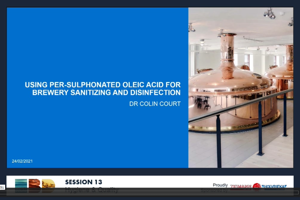 CIBD Membership Required
CIBD Membership Required
Using per-sulphonated oleic acid for brewery sanitizing and disinfection
By: Colin Court
24/02/2021
Discover combinations of PSOA and other peracids PSOA formulations, as they have a much reduced odour compared to the fatty acid based sanitisers prevalent in the brewery industry today. Peroxysulphonated oleic acid (PSOA) is a novel, patented peracid chemistry developed by Ecolab. When combined with other peracids PSOA formulations have high efficacy against a broad spectrum of microflora including yeasts and molds.
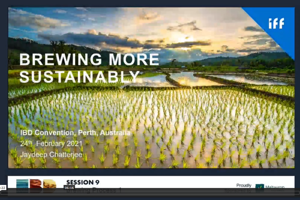 CIBD Membership Required
CIBD Membership Required
Brewing more sustainably
24/02/2021
DuPont Nutrition & Biosciences, a pioneer in providing enzymatic solutions to the Food & Beverages industry is addressing seven of the goals through cost effective enzymatic solutions. The seven goals where DuPont is focusing are zero hunger, sustainable cities and communities, good health and wellbeing, clean water and sanitation, affordable and clean energy, responsible consumption and climate action.
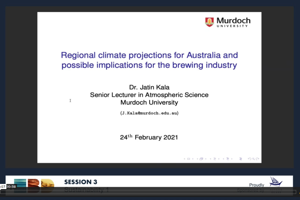 CIBD Membership Required
CIBD Membership Required
Regional climate projections for Australia and possible implications for the brewing industry
By: Jatin Kala
23/02/2021
Discover how regional climate models can be used to downscale global models down to resolutions of 5 to 10 km, and allowing for an improved representation of atmospheric processes which matter at the regional scale. You will be presented with regional climate projections of future climate change for different regions of Australia from regional climate simulations using state-of-the art regional climate models and how this will effect the brewing industry.
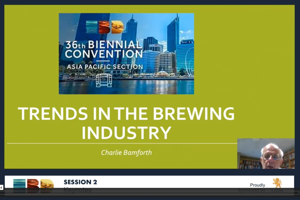 CIBD Membership Required
CIBD Membership Required
Trends in the brewing industry
By: Charlie Bamforth
23/02/2021
This video will summarise what we can expect in a brewing world post Covid. Where and when is the next technological leap going to be taken? Do we foresee truly disruptive change, or will we inch forward with gradual process evolution? What are the key underpinning requirements for tomorrow’s brewing world? How will the brewers of tomorrow be educated?
 CIBD Membership Required
CIBD Membership Required
Distilling whisky and beer based spirits by craft brewers
By: Axel Jany
23/02/2021
This paper will describe first-hand experience distilling set ups for brewers, shows recipes and results. With the ongoing worldwide Gin and Whisky trend, how does a start up craft distillery create a quality spirit, while adhering to the “3 year in a barrel” rule for calling it Whisky?
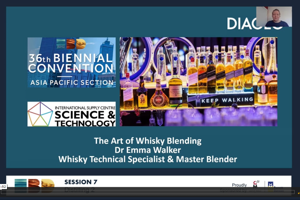 CIBD Membership Required
CIBD Membership Required
The art of whisky blending and single malt selection
By: Emma Walker
23/02/2021
Whisky has been made in Scotland for centuries, and creating whisky is the perfect balance between art and science, tradition and progress. Join the discussion of flavour creation, from lighter smoky complex style spirits and how these flavours develop in maturation to how the flavours are brought together.
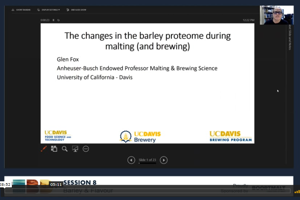 CIBD Membership Required
CIBD Membership Required
The changes in the barley proteome during malting
By: Glen Fox
24/02/2021
Barley protein content is considered critical in selecting suitable loads for malting. Our study explores changes in the proteome of a single variety during the malting process between two malthouses. Barley expressed protein such as LTP and Serpins were present during the malting process and these survive into beer, albeit with slight modifications to the protein structure.
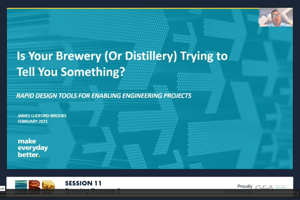 CIBD Membership Required
CIBD Membership Required
Is your brewery trying to tell you something?
24/02/2021
Reconnecting with your plant - rapid data capture techniques to enable engineering projects. Whether you have established engineering standards, drawings and up to date layouts, or find yourself in need of better plant information as you continue to grow organically, there are simple, cost effective solutions available to benchmark your current plant and build for the future.
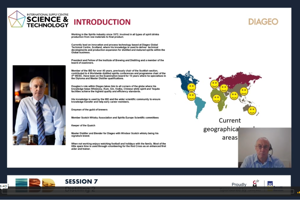 CIBD Membership Required
CIBD Membership Required
Development of flavour through distillation and maturation
By: Douglas Murray
23/02/2021
As a distiller you will be guided through the various operational opportunities that impact on the final style and flavour of the spirit beverage being produced. This presentation on flavour creating is based on innovation and research carried out over the last 45 years.
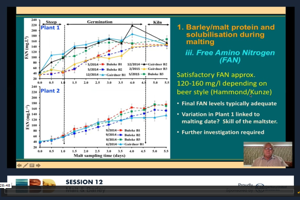 CIBD Membership Required
CIBD Membership Required
Malting quality during the malting process, barley to kilned malt
By: Evan Evans
24/02/2021
This investigation presents a holistic and comprehensive assessment of the step-wise changes in barley quality during the malting process for multiple batches of two Australian malting varieties (Buloke and Gairdner), in two modern, commercial-scale pneumatic malthouses.
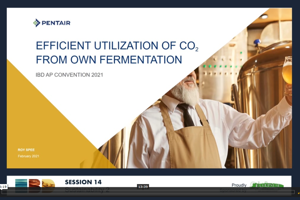 CIBD Membership Required
CIBD Membership Required
Utilizing CO2 from own fermentation is also valid for smaller breweries
By: Roy Spee
24/02/2021
Eliminate emissions (odors) from your fermentation process, recover your own CO2. CO2mpactBrew is a plug-and-play, containerized, CO2 recovery solution especially designed for small and mid-size breweries. It offers fast installation and easy relocate within a short time without compromising on quality and reliability.
 CIBD Membership Required
CIBD Membership Required
Developing fermented hop character in beer using hop oil extracts in beer
By: Colin Wilson
23/02/2021
Discover the collaboration between Totally Natural Solutions and Coopers Brewery. How they have looked at the sensory effects and value creation of additions of hop oil extract into primary and secondary fermentation, whilst retaining process control and consistent final beer sensory profile.
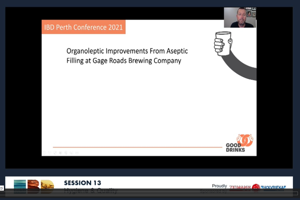 CIBD Membership Required
CIBD Membership Required
Improvements made from aseptic filling at Gage Roads
By: Matt Morisey
24/02/2021
Gage Roads have invested in upgraded filling capability to aseptic filling equipment for both bottles and cans. They are comitted to producing the highest quality products in Australia. This is an ambitious goal for a brewery producing 15 million litres annually but we stand by our motto of “Brewed by Fussy Bastards”!
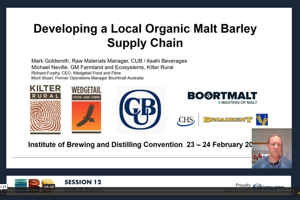 CIBD Membership Required
CIBD Membership Required
Developing a local organic malt barley supply chain
By: Mark Goldsmith
24/02/2021
Following the successful launch of Pure Blonde Organic Lager, CUB has partnered with Wedgetail Food & Fibre and Kilter Rural to produce a local source of organic malting barley. Together with Boortmalt we have built a certified local organic malt barley supply chain to provide a high quality sustainable alternative to imported malt.
 CIBD Membership Required
CIBD Membership Required
Efficient dry hopping of larger beer volumes with IMXD
By: Alyce Hartvigsen
23/02/2021
Dry hopped beers continue to enjoy popularity worldwide, and an increasing number of larger brewers are implementing the practice. However, there are a number of process challenges associated with the automation and scale-up of dry hopping techniques in larger breweries. Using Alfa Laval’s Iso-Mix External Drive (IMXD) System, a growing number of breweries have succeeded in optimizing the dry hopping of larger beer volumes, enjoying shorter in hop residence times, significant reductions in product losses and the elimination of process issues such as blockages from hop slugs.
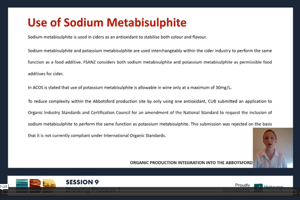 CIBD Membership Required
CIBD Membership Required
Organic production integration into an existing brewery
By: Katie Jessup
24/02/2021
As health and wellbeing trends change, organic produce segments are becoming increasingly important to the consumer and their health lifestyle. Discover how CUB identified an opportunity to strengthen the Pure Blonde Portfolio by introducing an 'Organic' claim to the brand. How the Abbotsford brewery embarked on a project to integrate organic production into its main brewing and cider facility, with the aim of utilising as much of the current infrastructure, asset base and workforce as possible, to brew and package an organic beer and cider.
 CIBD Membership Required
CIBD Membership Required
The application of metabolomics and genomics in hop breeding
By: Alexander Feiner
23/02/2021
The major goal of hop breeding is to develop new competitive varieties for an efficient and resource-saving hop industry. Resistance to diseases, pests and changing climatic conditions as well as consistency in yield and quality are specific breeding targets. An important tool to master these requirements is the implementation of molecular genetics and metabolomics. Studying the relationship between metabolite content levels and trait expression enables the identification of molecular processes involved in resistance against abiotic and biotic stress.
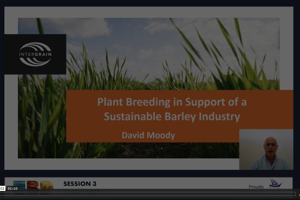 CIBD Membership Required
CIBD Membership Required
Barley breeding in an environment of sustainability
By: David Moody
23/02/2021
Barley breeding companies must address sustainability in terms of breeding business longevity, farmer profitability and environmental management, and the requirements of customers demanding a lower environmental footprint from the agricultural supply chain. The research being conducted by InterGrain supporting the development and use of these technologies will be described and the objectives that must be achieved during a period of significant climate change.
 CIBD Membership Required
CIBD Membership Required
Keynote Presentation
By: Phil Sexton
23/02/2021
Phil joined the brewing industry (Swan) in 1975 after completing a BSc at the University of Western Australia. He completed an MSc and co-founded the Matilda Bay Brewing Company in 1983. After the public takeover of Matilda Bay by Carlton and United Breweries (1990), Phil stood down as Executive Chairman and focussed upon Devils Lair as well as some restaurant, bar and coffee interests in Perth. In 1994-96, Phil moved to Portland Oregon to help a friend resuscitate the Bridgeport Brewery as well as expand a much larger brewery in Texas. Bridgeport IPA evolved out of this project. Returning to Australia, he sold Devils Lair and moved to the Yarra Valley to commence planting vineyards that are now the centrepiece of his Giant Steps/Innocent Bystander business based in Healesville. While developing the Yarra Valley vineyards, Phil joined some of his Matilda Bay colleagues and friends to create Little Creatures focussed upon naturally conditioned ales, arguing that this is what craft brewing needed to differentiate itself from large-scale commercial brewers.
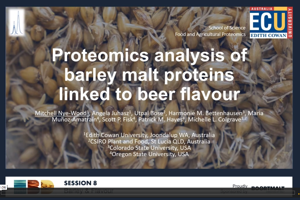 CIBD Membership Required
CIBD Membership Required
Proteomics analysis of barley malt proteins linked to beer flavour
24/02/2021
Discover the complex process of Malting, it aims to modify the physical structure of the barley grain and stimulate enzyme production or release leading to cell-wall degradation and protein solubilisation with minimal starch breakdown. In this study, two LC-MS/MS approaches employing multiple reaction monitoring (MRM) and a data-independent acquisition strategy were used to quantify the complex protein mixtures present in four barley varieties that yielded different flavour profiles.
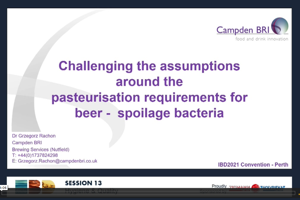 CIBD Membership Required
CIBD Membership Required
Challenging the assumptions around pasteurisation requirements of beer spoilage bacteria
By: Grzegorz Rachon
24/02/2021
Current recommendations for beer pasteurisation are based on the study in 1951 by Del Vecchio and co-workers. Discover the growth of eight of the 14 microorganisms into both beer styles, whilst different thermo tolerances were observed amongst the spoilage bacteria.
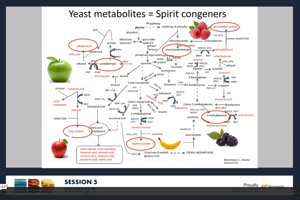 CIBD Membership Required
CIBD Membership Required
Diverse yeasts for distilled spirit fermentations
By: Graeme Walker
23/02/2021
Want to employ more flavoursome yeasts for certain distilled spirits? This presentation will focus on our research to evaluate non-Saccharomyces yeasts for Scotch whisky fermentations to impart desirable aroma and flavour congeners.
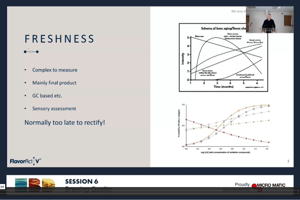 CIBD Membership Required
CIBD Membership Required
Analysing brewing processes to optimise freshness and extend shelf-life
By: Richard Boughton
23/02/2021
Today we see intense competition between beer brands but also with the beer category versus other beverages, for "market share of throat." While many beverages remain flavour stable for months, we know beer and juices lose freshness due to flavour change within a few weeks of packaging.
 CIBD Membership Required
CIBD Membership Required
How to keep control of what's lurking in your beer
By: Danielle Tromp
24/02/2021
Long shelf-life in beer is directly linked to a product free of any beer-spoilage microorganisms. While large brewing companies operate their own microbiological testing laboratories, microbial control is often difficult for small to midsized breweries as microbiological testing is performed by external laboratories on a less frequent basis. Delve into how specific PCR technologies are engineered towards easy operation and require no detailed scientific knowledge of handling and identifying microorganisms.
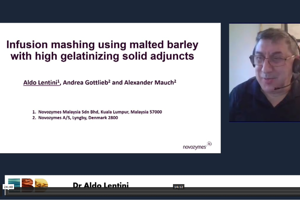 CIBD Membership Required
CIBD Membership Required
Infusion mashing using malted barley with high gelatinizing solid adjuncts
By: Aldo Lentini
24/02/2021
High gelatinizing adjuncts are often used in brewing to reduce costs and adapt features such as drinkability, flavor, taste and mouthfeel to brand-typical expectations. This paper discusses the use of and the outcome of using Ceremix Flex® during mashing, when producing worts from various types of solid adjuncts and at different malt to adjunct ratios.
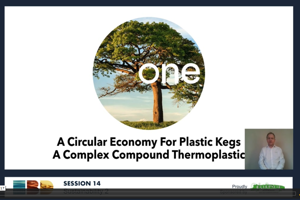 CIBD Membership Required
CIBD Membership Required
A circular economy for plastic kegs, a complex compound thermoplastic
By: Bert Hanssen
24/02/2021
Sustainability and circularity requires the help of the global community with a common goal to leave the world a better place. The used plastic kegs in the beverage industry is close to 65,000 tonnes. The recycling rate of plastics in Europe is approximately 42%. In Australia the plastics recycling rate in 2018 was 9.4%. This video will demonstrate that innovative product design can help to facilitate a circular solution, and in some circumstances plastic can be more sustainable than steel.
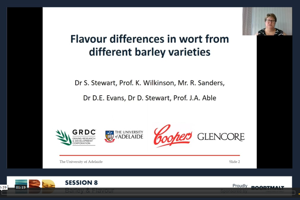 CIBD Membership Required
CIBD Membership Required
Barley derived flavours in wort and beer
By: Sue Stewart
24/02/2021
What is meant by flavour? This is a very complex question that many people have tried to explain. Flavour is essentially our combined perception of taste, aroma and mouth feel (tactile) properties. It adds to our enjoyment of beer which involves detection of a large number of contributing chemicals through interactions with olfactory and taste receptors in the nose and mouth. It is known is that you can impart flavour to beer by altering the malting regime, the choice of yeast and hop or specialty malt.
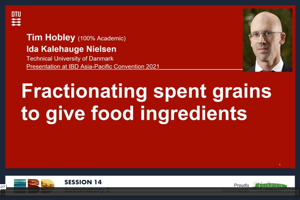 CIBD Membership Required
CIBD Membership Required
Fractionating special malt spent grains to give food ingredients
By: Timothy Hobley
24/02/2021
Extremely large amounts of brewers spent grains are produced each year, all year round and over the whole world. With the increasing focus on environmental sustainability and feeding the growing population, there is an accelerating interest in using spent grains to produce foods, drinks and ingredients, rather than animal food or waste. In this presentation, we extend our recent work and investigate how the rotary drum press can be used to produce a filtrate and a filter cake, in which functional compounds have been enriched.
 CIBD Membership Required
CIBD Membership Required
Avoiding digital disappointment: digital transformation in brewing and distilling
By: Leonie Wong
24/02/2021
How do you identify the innovations that are right for your operation and turn them into reality with the right return on investment? Brewers and distillers of all sizes need to innovate in order to provide a quality product. Digital transformation is something that can and should be embraced by everyone in your business. Siemens has been supporting companies with navigating the digital transformation journey.
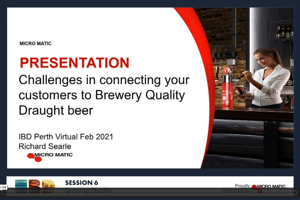 CIBD Membership Required
CIBD Membership Required
Challenges in connecting your customers to brewery quality draught beer
By: Richard Searle
23/02/2021
Draught beer is the most profitable and environmentally sustainable way of connecting your customers, both retailers and end consumers, with Brewery Quality beer. However studies have shown that up to fifty percent of Draught beer can be negatively affected by quality issues in Trade, from poor hygiene, temperature and gas pressure. Review the current challenges and trends in Draught beer dispense, including the continued move to smaller twenty litre slim kegs.
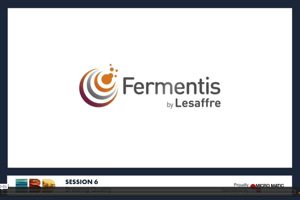 CIBD Membership Required
CIBD Membership Required
No and Low-alcohol beer production through fermentation
23/02/2021
Consumer demand for lower alcohol products is an innovation driver in the brewing today industry. Fermentis have researched techniques for producing low alcohol beer without using post-fermentation physical separation. The presentation will present techniques to produce low alcoholic beers.
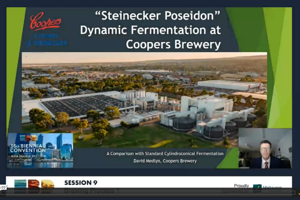 CIBD Membership Required
CIBD Membership Required
A comparative study of Krones PoseidonTM dynamic fermentation contrasted to conventional fermentation and conditioning in cylindroconical vessels
By: David Medlyn
23/02/2021
Coopers Brewery have commissioned the retrofitting of eight fermenters with Krones Poseidon dynamic fermentation alongside an identical set of eight cylindroconical vessels. They will discuss how Dynamic fermentation was used in several different ways and the pros and cons of each.
 CIBD Membership Required
CIBD Membership Required
Automating copper pot still operation in malt whisky production
23/02/2021
The presentation describes how the application of in-line instrumentation to the operation and control of the pot still operation in conjunction with an automated control system has allowed the operation of the stills and the separation of the cuts to become an automated operation and enabled improvements in product quality and reductions in manning in Scottish malt whisky distilleries.
Some of the content requires an active membership to view.
You can find out more here
Some of the content requires an active membership to view.
You can find out more here
